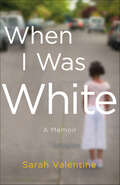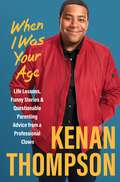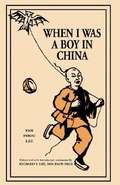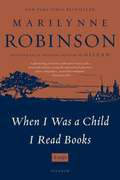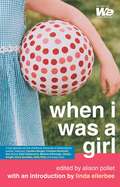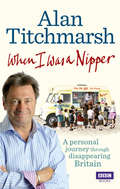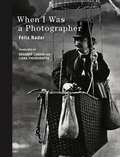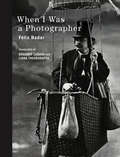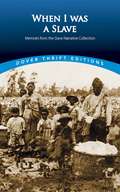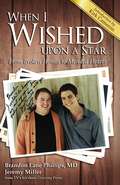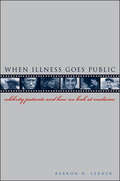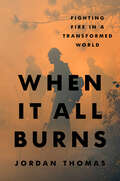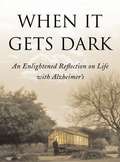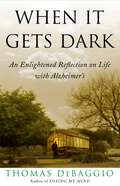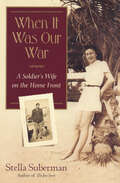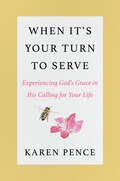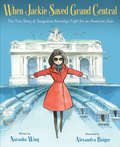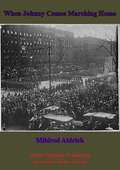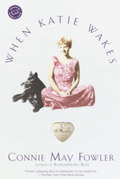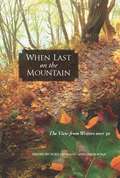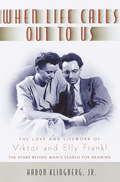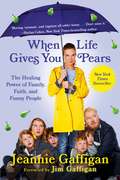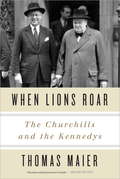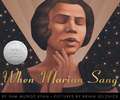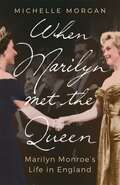- Table View
- List View
When I Was White: A Memoir
by Sarah ValentineThe stunning and provocative coming-of-age memoir about Sarah Valentine's childhood as a white girl in the suburbs of Pittsburgh, and her discovery that her father was a black man.At the age of 27, Sarah Valentine discovered that she was not, in fact, the white girl she had always believed herself to be. She learned the truth of her paternity: that her father was a black man. And she learned the truth about her own identity: mixed race.And so Sarah began the difficult and absorbing journey of changing her identity from white to black. In this memoir, Sarah details the story of the discovery of her identity, how she overcame depression to come to terms with this identity, and, perhaps most importantly, asks: why? Her entire family and community had conspired to maintain her white identity. The supreme discomfort her white family and community felt about addressing issues of race–her race–is a microcosm of race relationships in America.A black woman who lived her formative years identifying as white, Sarah's story is a kind of Rachel Dolezal in reverse, though her "passing" was less intentional than conspiracy. This memoir is an examination of the cost of being black in America, and how one woman threw off the racial identity she'd grown up with, in order to embrace a new one.
When I Was Your Age: Life Lessons, Funny Stories & Questionable Parenting Advice from a Professional Clown
by Kenan ThompsonWhen I Was Your Age is a hilarious, heartwarming and surprising ode to growing up, getting older and wiser, and luck, life, and learning from the school of hard knocks, from SNL's longest-serving actor, Kenan ThompsonKenan Thompson is Saturday Night Live’s longest-ever-serving cast member and a star of such pioneering sketches as “Black Jeopardy” and is hugely beloved thanks to a tidal wave of nostalgic fans who grew up on early 2000s classics All That, Good Burger, and Kenan & Kel on Nickelodeon.He’s also a dad (to two girls) in his mid-40s living in suburbia, and whose universal, relatable, family-friendly humor has created unbelievable appeal and engagement from fans from middle America to coastal elites. Becoming a dad sucked the cool right out of him -- and he's OK with that!When I Was Your Age is packed with hilarious yet poignant essays that are aimed to offer any reader valuable advice on parenting, focusing on positivity, and having fun in life. Kids, new parents, fellow fathers, budding comics, and aunties who want to pinch his cheeks, can all learn from his biggest mistakes and most triumphant victories. There’s something for everybody here!
When I Was a Boy in China
by Richard V. Lee Yan Phou LeeThis book was originally published in the late nineteenth century. The author tells the story of his boyhood in China.
When I Was a Child I Read Books
by Marilynne RobinsonWhen I Was a Child I Read Books' tackles the charged political and social climate in this country, the deeply embedded role of generosity in Christian faith, and the nature of individualism and the myth of the American West.
When I Was a Girl
by Alison PolletDiscover the defining moments and fondest memories of some of the world's most celebrated women!Based on the popular WE: Women's Entertainment television series and featuring an introduction by famed television journalist and author Linda Ellerbee,When I Was a Girlpresents a collection of timeless girlhood tales. Extraordinary women from the worlds of politics, sports, entertainment, literature, music, and beyond relive the early moments that shaped them: the first friendships and academic pitfalls, the consuming crushes and favorite outfits. These are some of the remarkable women who offer a glimpse into what inspired them when they were girls:Gillian AndersonIndia. ArieCandice BergenEllen BurstynCandace BushnellAnn CurryEllen DeGeneresIlleana DouglasMarian Wright EdelmanMelissa EtheridgeEdie FalcoFionnula FlanaganSue GraftonDenyce GravesMelanie GriffithCherry JonesGladys KnightLisa LeslieSusan LucciWendie MalickRita MorenoDee Dee MyersCynthia NixonElizabeth PerkinsKelly PrestonAnna QuindlenSally RideMichelle RodriguezAmy SedarisJamie-Lynn SiglerMary SteenburgenLee Ann WomackAnd many more!Here are cherished memories, evocative and insightful, for every woman who recalls fondly what she was like. . . when she was a girl. For more information on WE: Women's Entertainment and the seriesWhen I Was a Girllog on to www. we. tv.
When I Was a Nipper: The Way We Were in Disappearing Britain
by Alan TitchmarshIn When I Was a Nipper Alan Titchmarsh goes on a personal and nostalgic journey through post-War Britain in search of treasured values and traditions that were once the soul of society. With characteristic wit, warmth and humour he draws on the experience of his own childhood, and also takes a broader perspective, creating a wonderfully detailed and evocative portrait of a way of life that is fast disappearing, and asks what can we learn from this era of austerity to make our lives better today?Born in Yorkshire in 1949 and brought up in a Britain still recovering from World War 2, Alan remembers a time of relative calm, when it was enough to return home at night knowing that the house would still be standing. We were known throughout the world for our patience, resourcefulness and resilience. 'Mustn't grumble' was almost a national catchphrase, and queuing was second nature. Peppered with wonderful archive photographs and advertisements, When I Was a Nipper takes us back to those days, down high streets and through farmyards, on to trolley buses and into local pubs. As we move towards a global economy, as communities fragment and customs are lost, When I Was a Nipper captures a world that is fast receding into history. It's powerfully nostalgic for those who remember those days, but it's also Alan's timely call to all recession-hit Brits to heed the lessons of austerity Britain: 'make do and mend'; 'look on the bright side' and 'take the knocks on the chin'.
When I Was a Photographer
by Felix Nadar Eduardo Cadava Liana TheodoratouCelebrated nineteenth-century photographer -- and writer, actor, caricaturist, inventor, and balloonist -- Félix Nadar published this memoir of his photographic life in 1900 at the age of eighty. Composed as a series of vignettes (we might view them as a series of "written photographs"), this intelligent and witty book offers stories of Nadar's experiences in the early years of photography, memorable character sketches, and meditations on history. It is a classic work, cited by writers from Walter Benjamin to Rosalind Krauss. This is its first and only complete English translation. In When I Was a Photographer (Quand j'étais photographe), Nadar tells us about his descent into the sewers and catacombs of Paris, where he experimented with the use of artificial lighting, and his ascent into the skies over Paris in a hot air balloon, from which he took the first aerial photographs. He recounts his "postal photography" during the 1870-1871 Siege of Paris -- an amazing scheme involving micrographic images and carrier pigeons. He describes technical innovations and important figures in photography, and offers a thoughtful consideration of society and culture; but he also writes entertainingly about such matters as Balzac's terror of being photographed, the impact of a photograph on a celebrated murder case, and the difference between male and female clients. Nadar's memoir captures, as surely as his photographs, traces of a vanished era.
When I Was a Photographer
by Felix NadarThe first complete English translation of Nadar's intelligent and witty memoir, a series of vignettes that capture his experiences in the early days of photography.Celebrated nineteenth-century photographer—and writer, actor, caricaturist, inventor, and balloonist—Félix Nadar published this memoir of his photographic life in 1900 at the age of eighty. Composed as a series of vignettes (we might view them as a series of “written photographs”), this intelligent and witty book offers stories of Nadar's experiences in the early years of photography, memorable character sketches, and meditations on history. It is a classic work, cited by writers from Walter Benjamin to Rosalind Krauss. This is its first and only complete English translation.In When I Was a Photographer (Quand j'étais photographe), Nadar tells us about his descent into the sewers and catacombs of Paris, where he experimented with the use of artificial lighting, and his ascent into the skies over Paris in a hot air balloon, from which he took the first aerial photographs. He recounts his “postal photography” during the 1870-1871 Siege of Paris—an amazing scheme involving micrographic images and carrier pigeons. He describes technical innovations and important figures in photography, and offers a thoughtful consideration of society and culture; but he also writes entertainingly about such matters as Balzac's terror of being photographed, the impact of a photograph on a celebrated murder case, and the difference between male and female clients. Nadar's memoir captures, as surely as his photographs, traces of a vanished era.
When I Was a Slave: Memoirs from the Slave Narrative Collection (Dover Thrift Editions)
by Norman R. YetmanMore than 2,000 interviews with former slaves, who, in blunt, simple language, provide often-startling first-person accounts of their lives in bondage. Includes some of the most detailed, compelling, and engrossing life histories in the Slave Narrative Collection, a project funded by the U.S. Government. An illuminating source of information.
When I Wished upon a Star: From Broken Homes to Mended Hearts
by Brandon Lane Phillips Jeremy James MillerGrowing up as a patient with congenital heart disease, Brandon Lane Phillips often felt alone. He knew no one else who had his heart condition and believed no one understood his condition. Brandon believed he would die young. Like many congenital heart patients, he wondered if he would have a long life. It is only natural to question one’s mortality when open-heart surgery is what enabled you to survive childhood.Brandon worried that his heart defect caused his parents’ divorce and questioned just how much his illness had affected his siblings since so much extra attention was devoted to him. He longed to have the type of close relationship with his father that he saw on many of his favorite TV shows.At 11 years of age, he was so desperate to find answers that he asked God to show him that He loved him. Soon after, he received a wish to meet child actor Jeremy Miller from TV’s Growing Pains. Brandon had wished to meet him because he envied his “perfect” fictional family. After one of the show’s stars told Brandon that God had a plan for his life, Brandon left the set that evening feeling that the trip had been orchestrated as an answer to his prayer.There are several God-like coincidences that occur along Brandon’s path of becoming a pediatric cardiologist. Many times when Brandon would face a life experience big enough to shake his faith, an improbable experience would occur that would remind him of his wish and God’s answer to his prayer. Throughout his career, he would encounter other patients who felt alone and had questions about their own mortality.Brandon chose medicine as his profession because he greatly admired his childhood pediatric cardiologist. And even though a need for a second open-heart surgery at the beginning of medical school threatened Brandon’s dream of becoming a physician, he would ultimately be trained by the very physicians who had cared for him.Brandon’s journey of hope found within the pages of When I Wished Upon a Star is a story of giving back and finding purpose in life through the intervention of God’s great grace and perfect timing.The other life examined in this book belongs to Jeremy Miller, child actor, celebrity wish, and the friend who played an important role in Brandon’s journey. Brandon’s life truly changed forever after having met Jeremy on the television set of Growing Pains.While Brandon was dealing with his struggles, so too was Jeremy. In When I Wished Upon a Star, Jeremy shares “secrets” from his childhood that have previously gone untold. It would be easy to say that Jeremy was a child star, and that historically, most child stars aren’t expected to have a good end. Still Jeremy’s secrets shocked Brandon and brought him to tears. They also shed light on the reason for Jeremy’s battle with alcohol. Brandon would learn that Jeremy, too, envied the life that his fictional character lived. And so when the TV show ended, Jeremy almost did too.At the time of his wish, only God could have predicted how Brandon’s life and those of the stars of his favorite TV show would intertwine in the decades to follow; no one could have foreseen that a wish made by a young boy would give both he and Jeremy hope for their future and help them find purpose in the lives they were created for by a loving God--lives that would live on despite troubles and despair.Brandon was meant to use the experiences of his childhood to help others. It is the only way to explain how his life has come full circle time and time again.
When Illness Goes Public: Celebrity Patients and How We Look at Medicine
by Barron H. LernerOutstanding Academic Title, 2007, Choice magazineSteve McQueen had cancer and was keeping it secret. Then the media found out, and soon all of America knew. McQueen’s high profile changed forever the way the public perceived a dreaded disease. In When Illness Goes Public, Barron H. Lerner describes the evolution of celebrities' illnesses from private matters to stories of great public interest. Famous people who have become symbols of illness include Lou Gehrig, the first "celebrity patient"; Rita Hayworth, whose Alzheimer disease went undiagnosed for years; and Arthur Ashe, who courageously went public with his AIDS diagnosis before the media could reveal his secret. And then there are private citizens like Barney Clark, the first recipient of a permanent artificial heart, and Lorenzo Odone, whose neurological disorder became the subject of a Hollywood film. While celebrity illnesses have helped to inform patients about treatment options, ethical controversies, and scientific proof, the stories surrounding these illnesses have also assumed mythical characteristics that may be misleading. Marrying great storytelling to an exploration of the intersection of science, journalism, fame, and legend, this book is a groundbreaking contribution to our understanding of health and illness.
When It All Burns: Fighting Fire in a Transformed World
by Jordan ThomasA hotshot firefighter&’s gripping firsthand account of a record-setting fire seasonEighteen of California&’s largest wildfires on record have burned in the past two decades. Scientists recently invented the term &“megafire&” to describe wildfires that behave in ways that would have been nearly impossible just a generation ago, burning through winter, exploding in the night, and devastating landscapes historically impervious to incendiary destruction.In When It All Burns, wildland firefighter and anthropologist Jordan Thomas recounts a single, brutal six-month fire season with the Los Padres Hotshots—the special forces of America&’s firefighters. Being a hotshot is among the most difficult jobs on earth. Thomas viscerally renders his crew&’s attempts to battle flames that are often too destructive to contain. He uncovers the hidden cultural history of megafires, revealing how humanity&’s symbiotic relationship with wildfire became a war—and what can be done to change it back. Thomas weaves ecology and the history of Indigenous peoples' oppression, federal forestry, and the growth of the fire industrial complex into a riveting narrative about a new phase in the climate crisis. It's an immersive story of community in the most perilous of circumstances, told with humor, humility, and affection.
When It Gets Dark
by Thomas DebaggioWith his first memoir,Losing My Mind, Thomas DeBaggio stunned readers by laying bare his faltering mind in a haunting and beautiful meditation on the centrality of memory to human life, and on his loss of it to early-onset Alzheimer's disease. In this second extraordinary narrative, he confronts the ultimate loss: that of life. And as only DeBaggio could, he treats death as something to honor, to marvel at, to learn from. Charting the progression of his disease with breathtaking honesty, DeBaggio deftly describes the frustration, grief, and terror of grappling with his deteriorating intellectual faculties. Even more affecting, the prose itself masterfully represents the mental vicissitudes of his disease -- DeBaggio's fragments of memory, observation, and rumination surface and subside in the reader's experience much as they might in his own mind. His frank, lilting voice and abundant sense of wonder bind these fragments into a fluid and poetic portrait of life and loss. Over the course of the book, DeBaggio revisits many of the people, places, and events of his life, both in his memory and in fact. In a sense, he is saying goodbye, paying his respects to the world as it recedes from him -- and it is a poignant irony that even as this happens, he is at the height of his remarkable descriptive powers. In his moments of clarity, his love for life's details only grows deeper and richer: the limestone creek where he has fished for years; his satisfying and lonely herb farming days; the goldfish pond his son designed and built in his backyard in honor of DeBaggio's passion for "any hole in the ground with some liquid in it"; the thirty years in his beloved home in Arlington, Virginia; his early career as a muckraker; the innumerable precious moments spent with his wife and son; his belated grief over his parents' deaths. Adeptly navigating between elegy and celebration, fear and determination, confusion and clarity, DeBaggio delivers an exquisitely moving and inspiring book that will resonate with all those who have grappled with their own or their loved ones' memory loss and with death.
When It Gets Dark: An Enlightened Reflection on Life with Alzheimer's
by Thomas DeBaggioAdeptly navigating between elegy and celebration, fear and determination, confusion and clarity, DeBaggio delivers an exquisitely moving and inspiring book that will resonate with all those who have grappled with their own or their loved ones' memory loss and with death.With his first memoir, Losing My Mind, Thomas DeBaggio stunned readers by laying bare his faltering mind in a haunting and beautiful meditation on the centrality of memory to human life, and on his loss of it to early-onset Alzheimer's disease. In this second extraordinary narrative, he confronts the ultimate loss: that of life. And as only DeBaggio could, he treats death as something to honor, to marvel at, to learn from. Charting the progression of his disease with breathtaking honesty, DeBaggio deftly describes the frustration, grief, and terror of grappling with his deteriorating intellectual faculties. Even more affecting, the prose itself masterfully represents the mental vicissitudes of his disease—DeBaggio's fragments of memory, observation, and rumination surface and subside in the reader's experience much as they might in his own mind. His frank, lilting voice and abundant sense of wonder bind these fragments into a fluid and poetic portrait of life and loss. Over the course of the book, DeBaggio revisits many of the people, places, and events of his life, both in his memory and in fact. In a sense, he is saying goodbye, paying his respects to the world as it recedes from him—and it is a poignant irony that even as this happens, he is at the height of his remarkable descriptive powers. In his moments of clarity, his love for life's details only grows deeper and richer: the limestone creek where he has fished for years; his satisfying and lonely herb farming days; the goldfish pond his son designed and built in his backyard in honor of DeBaggio's passion for "any hole in the ground with some liquid in it"; the thirty years in his beloved home in Arlington, Virginia; his early career as a muckraker; the innumerable precious moments spent with his wife and son; his belated grief over his parents' deaths.
When It Was Our War: A Soldier's Wife on the Home Front
by Stella SubermanWhen Stella Suberman wrote her first memoir, The Jew Store, at the age of seventy-six, she was widely praised for shedding light on a forgotten piece of American history--Jewish life in the rural South. In her new memoir, Suberman reveals yet another overlooked aspect of America's past--the domestic side of war. Her story begins in the Miami Beach she grew up in, when hotel signs boasted "Always a View, Never a Jew" and where a passenger ship lingered just off shore carrying hundreds of European Jews hoping for--but never finding--sanctuary. It was a time of innocence, before that war in Europe became our war. Stella was nineteen when America entered the fighting. By the time she was twenty-three, the war was over. She married Jack Suberman the week he enlisted and set out alone to join him in California. She was kicked off trains to make room for soldiers, her luggage was stolen, she was arrested for soliciting, but she was determined to follow her husband. And she did so for the next four years as he was sent from air base to air base, first training to be a bombardier and then training others. It wasn't until he was sent overseas to fly combat missions that she finally went back home to wait, as did so many other soldier's wives. This remarkable memoir renders a double understanding of war--of how it matured a young woman and how it matured a country. By personalizing the patriotism of the 1940s, Stella Suberman's story becomes the story of all military wives and serves as a powerful reminder of how differently many Americans feel about war sixty years later.
When It's Your Turn to Serve: Experiencing God's Grace in His Calling for Your Life
by Karen PenceLife is full of unexpected obstacles, but there’s no challenge too big for God to handle. Washington D.C. is crammed with people eager to bend your ear about statistics, polls, and policies. Karen Pence is more likely to talk about beekeeping—if she’s not busy teaching an art class, painting watercolors, or riding her bike.An elementary schoolteacher who never expected to leave Indiana, Karen found during her extraordinary journey to becoming Second Lady that—despite the turbulence inherent to political campaigning, and through eighteen moves and countless surprises—God’s grace was sufficient.When It’s Your Turn to Serve is full of heartwarming and relatable stories of being a leader, a teacher, a mom, and a Christian throughout an unpredictable life. From turning up to “Pet Night” on Capitol Hill toting a lizard, two cats, and a dog—only to find it was an event for lobbyists—to getting the unexpected news that her husband had become Donald Trump’s nominee for vice president, Karen has learned to take surprises in stride. In this warm and deeply personal book, the former second lady shares the lessons she’s learned about God, faith, and family. Brimming with stories that mattered but didn’t make the headlines, the book challenges you to be open when opportunities arise, recognize your purpose in God’s plan, and step up to make a difference when it’s your turn.
When Jackie Saved Grand Central: The True Story of Jacqueline Kennedy's Fight for an American Icon
by Natasha Wing Alexandra BoigerBefore she was an iconic First Lady of the United States, Jackie Kennedy was a born-and-raised New Yorker. She loved everything about her city, from the natural beauty of the parks to the architectural history of the buildings. So when the owners of Grand Central wanted to build a skyscraper on top of the famous train station, Jackie knew they had to be stopped. She helped inspire thousands of people to come together and fight to protect the historic landmark. From letter-writing campaigns all the way to the Supreme Court, this little-known story celebrates winning in the face of immeasurable odds and how one person can make a big difference.
When Johnny Comes Marching Home
by Mildred AldrichMildred Aldrich was born in Providence, Rhode Island, in 1853. After graduating from Everett High School in 1872, she taught elementary school in Boston, Massachusetts.Aldrich began her career as a journalist with the Boston Home Journal and later contributed to Arena and the Boston Herald. For a short period in 1892, she also edited the magazine, The Mahogany Tree.In 1898, Aldrich moved to France and while living in Paris became a close friend of Gertrude Stein. Aldrich worked as a foreign correspondent and newspaper critic until retiring to Huiry, a village on the outskirts of Paris. She wrote to Stein in June 1914: "It will be the bloodiest affair the world has ever seen - a war in the air, under the sea as well as on it, and carried out with the most effective man-slaughtering machines ever used in battle."During the First World War, Aldrich wrote A Hilltop on the Marne (1915), a book based on her journal entries (3rd June - 8th September 1914) and on letters she wrote to Gertrude Stein. The book sold well in the United States and she followed it with On the Edge of the War Zone (1917), The Peak of the Load (1918) and When Johnny Comes Marching Home (1919).The French government believed that Aldrich's work helped persuade the US government to declare war on Germany and in 1922 was awarded the Legion of Honour.Mildred Aldrich died in Huiry, France, on 19th February, 1928.Text taken, whole and complete, from the edition published in Boston, Small, Maynard and Company, 1919.Original Page Count - 286 pages.
When Katie Wakes
by Connie May FowlerBestselling author Connie May Fowler tells her own extraordinary story for the first time-the harrowing years of her childhood followed by the abusive relationship she endured as a young woman-and how the unconditional love of her dog helped her escape her physical and emotional bonds.Before Women Had Wings, Connie May Fowler's award-winning and bestselling fictional account of domestic abuse, touched thousands. In this piercing memoir, Fowler chronicles the emotional battery and physical abuse that marked her own passage to adulthood. She draws a searing portrait of growing up with her manipulative and needy mother, a woman unable to give the love and comfort every child has a right to expect. And then, as a young woman, Fowler found herself involved with a man whose behavior disturbingly echoed her mother's. The man she lived with alternately displayed a desperate need for her or rejected her as if she were worse than useless. With heart-wrenching candor, Fowler records the abuse she suffered at his hands, from his constant attempts to undermine her self- confidence to his acts of brutal physical violence. The unconditional love Fowler longed for finally came-in the shape of an adoring Labrador puppy named Kateland. With Katie at her side, she was able to withstand her mistreatment and the crushing weight of her childhood and, miraculously, managed to create a small refuge from the horrors that surrounded her. This is the story of her decision to end the years of mistreatment and even to open her life to a new, gentle man, whose love and understanding helped to transform her. Well known for her fiction and her work with victims of domestic abuse, Fowler now offers a strong helping hand to women everywhere in this startling, revealing, and ultimately inspiring memoir.From the Hardcover edition.
When Last on the Mountain
by Vicky Lettmann Carol Roan"When Last on the Mountain is an open look at the many and astonishing ways our bodies bear both curses and blessing and is a testament to our abiding need to address in language and image the body's sure and swift betrayals. From a vantage point of life after fifty, with grace and humor these writers peer soberly at the future while maintaining their gaze on the past."-Gina Ochsner, author of The Russian Dreambook of Color and Flight"A fun and varied read. Insightful, witty, and sometimes heartbreaking selections, but all with an underlying fire for life."-Will Weaver, author of Sweet Land: New & Selected Stories"Who better to bear witness to the slings and arrows of outrageous fortune than writers over 50? The voices of experience collected by Lettmann and Roan are generous in their honest specificity. Prospective readers can be assured of a good and meaningful time with these stories, essays and poems."-Sam Hodges, reporter for The Dallas Morning News and author of B-Four"When Last on the Mountain is a book full of treasures. From these writers comes work of substance, surprise, and death-defying candor. To read these pieces is to be inside an art that sifts through comedy, irony, and hard facts to offer the intensely interesting (yes) exhilarations of the long view."-Joan Silber, author of Ideas of Heaven: A Ring of Stories and The Size of the World"One day I will write my last downhill run, not on snow, but on paper. Not today. No. I dance, stop, dance, stop, dance, dance, dance down the mountain."-Kaye Bache-SnyderWhat sets these writers apart? Until we reach fifty, how we live and write is colored by our futures: those we expect to have and those we imagine. The perspective of the over-fifty writer takes on the hues of both past and future, tinted by memories of first loves, stained by memories of war and loss, and made more poignant by the knowledge that this spring's blooms or this morning's cup of coffee with a beloved husband may be the last and must be savored fully.These essays, stories, and poems were chosen from more than two thousand submissions of previously unpublished work. Some of the contributors-a poet laureate, a Pulitzer Prize nominee, a former foreign correspondent-have long literary histories; others-a social worker, a civil service employee, a clergywoman-began to write later in life. All of them were inspired by a call that asked for fresh and honest writing from the fullness of their lives.Vicky Lettmann, who writes fiction, essays, and poetry, served as an editor for the literary/arts magazines Speakeasy (the Loft Literary Center) and Under Construction (North Hennepin Community College). She received an MFA in fiction writing from Warren Wilson College. Her work has appeared in Twenty-Six Minnesota Writers (Nodin Press) and in Beloved on the Earth: 150 Poems of Grief and Gratitude (Holy Cow! Press).Carol Roan teaches voice and stage presence in Winston-Salem, North Carolina. She is the author of Clues to American Dance (Starrhill Press) and Speak Easy: A Guide to Successful Performances, Presentations, Speeches, and Lectures (Starrhill Press), and she writes a column on the "art of performance" for an online 'zine. She won a fellowship to Summer Literary Seminars, Russia, in 2006.
When Life Calls Out to Us: The Love and Lifework of Viktor and Elly Frankl
by Haddon Klingberg Jr."The only authorized biography of Victor Frankl, whose life story and reflections have inspired tens of millions. Haddon Klingberg records and preserves the Frankl legacy, with his own eloquent and moving reflections." -- David G. Myers, Hope College, author of The American Paradox: Spiritual Hunger in an Age of Plenty. Written in response to the horrors he experienced and witnessed during the Holocaust, Viktor Frankl's landmark book, Man's Search for Meaning, has sold millions of copies and been translated into twenty-seven languages. But although Frankl's thought and philosophy have been widely analyzed, until now little has been written about his life, and about the deeply loving, intensely spiritual relationship that led him and his wife to dedicate their lives to reducing pain and oppression in the world. In a book that is at once a wonderful love story and a tribute to two extraordinary people, Haddon Klingberg, Jr., draws on a wealth of anecdotes, told to him by the Frankls themselves, to describe their separate early lives and their fifty-two years as husband and wife. Returning to Vienna after spending three years in four different concentration camps, Frankl, whose first wife and family died in the camps, turned to writing as a way of finding some purpose in his life. But it was Elly Schwindt, a woman half his age, who helped him put the pieces of his broken life together. Married in 1947, the Frankls created a life of hope and faith, a life committed to proclaiming the oneness of the human family, challenging materialistic values, and encouraging the pursuit of meaning. When Life Calls Out to Us chronicles a spiritual journey infused with tragedy but sustained by love, wisdom, faith, and humor. Klingberg's extensive interviews, not available anywhere else, reveal the full richness of the Frankls' lives and beautifully illuminate their enduring contributions toward a better world for all people.
When Life Gives You Pears: The Healing Power of Family, Faith, and Funny People
by Jeannie GaffiganIn a book that is The Big Sick meets Dad is Fat, Jeannie Gaffigan, writer/director/producer/accused supermom and wife of bestselling author/comedian Jim Gaffigan, writes with humor and heart about the pear-sized brain tumor she had removed, the toll it took on her enormous family, and the priceless lessons she learned along the way. <P><P>In 2017, Jeannie's life came to a crashing halt when she was diagnosed with a life-threatening brain tumor. <P><P>As the mother of 5 kids-6 if you include her husband-sat in the neurosurgery department in star-covered sweats too whimsical for the seriousness of the situation, all she could think was "Am I going to die?" <P><P>Thankfully, Jeannie and her family were able to survive their time of crisis, and now she is sharing her deeply personal journey through this miraculous story: the challenging conversations she had with her children; how she came to terms with feeling powerless and ferociously crabby while bedridden and unable to eat for a month; and how she ultimately learned, re-learned and re re-learned to be more present in life.With sincerity and hilarity, Jeannie invites you into her heart (and brain) during this trying time, emphasizing the importance of family, faith and humor as keys to her recovery and leading a more fulfilling life. <P><P><b>A New York Times Bestseller</b>
When Lions Roar
by Thomas MaierThe first comprehensive history of the deeply entwined personal and public lives of the Churchills and the Kennedys and what their "special relationship" meant for Great Britain and the United States When Lions Roar begins in the mid-1930s at Chartwell, Winston Churchill's country estate, with new revelations surrounding a secret business deal orchestrated by Joseph P. Kennedy, the soon-to-be American ambassador to Great Britain and the father of future American president John F. Kennedy. From London to America, these two powerful families shared an ever-widening circle of friends, lovers, and political associates - soon shattered by World War II, spying, sexual infidelity, and the tragic deaths of JFK's sister Kathleen and his older brother Joe Jr. By the 1960s and JFK's presidency, the Churchills and the Kennedys had overcome their bitter differences and helped to define the "greatness" in each other. Acclaimed biographer Thomas Maier tells this dynastic saga through fathers and their sons - and the remarkable women in their lives - providing keen insight into the Churchill and Kennedy families and the profound forces of duty, loyalty, courage and ambition that shaped them. He explores the seismic impact of Winston Churchill on JFK and American policy, wrestling anew with the legacy of two titans of the twentieth century. Maier also delves deeply into the conflicted bond between Winston and his son, Randolph, and the contrasting example of patriarch Joe Kennedy, a failed politician who successfully channeled his personal ambitions to his children. By approaching these iconic figures from a new perspective, Maier not only illuminates the intricacies of this all-important cross-Atlantic allegiance but also enriches our understanding of the tumultuous time in which they lived and the world events they so greatly influenced. With deeply human portraits of these flawed but larger-than-life figures, When Lions Roar explores the "special relationship" between the Churchills and Kennedys, and between Great Britain and the United States, highlighting all of its emotional complexity and historic significance.From the Hardcover edition.
When Marian Sang: The True Recital of Marian Anderson, The Voice of a Century
by Pam Muñoz RyanAn introduction to the life of Marian Anderson, extraordinary singer and the first African American to perform with the Metropolitan Opera, whose life and career encouraged social change.<P><P> Winner of the Sibert Honor
When Marilyn Met the Queen: Marilyn Monroe's Life in England
by Michelle Morgan'England? It seemed to be raining the whole time . . . Or maybe it was me'MARILYN MONROEIn July 1956, Marilyn Monroe arrived in London, on honeymoon with her husband Arthur Miller, to make The Sleeping Prince (later released as The Prince and the Showgirl) with Laurence Olivier. When the couple arrived at London Airport, they were looking forward to a peaceful stay. Marilyn would work during the day at Pinewood Studios, while Arthur would write. Then, in the evening, the couple would be able to relax together in their private English country cottage. It didn't quite turn out that way.The 'cottage' was actually a mansion, which belonged to Lord Drogheda, the managing director of the Financial Times. Raised in tiny hotel rooms and apartments, Marilyn felt herself being watched. She was, by Lord Drogheda's servants, who were selling stories to the papers. When filming began, it was a disaster. Director Joshua Logan had written to Olivier, offering advice on how to handle Marilyn as an actress, but Olivier ignored him. Instead, he condescended to her in his introduction to the cast, pooh-poohed her views on acting, and dismissed her stage-fright as an inconvenience. Marilyn grew to hate Olivier with a passion; the feeling was mutual.Marilyn found herself torn between settling into married life, being a curiosity for the frequently hostile British press, and her work on The Prince and the Showgirl. She took solace in small acts of kindness from members of the public, and a new fascination with Queen Elizabeth.Marilyn made a point of adopting some of the Queen's favourite brands, buying gloves from Cornelia James, perfume from Floris, and switching from Chanel No. 5 to Yardley's Lavender. Marilyn made a point of asking the film's PR manager to add a royal meeting to her schedule, but each day Olivier would delete the request. Michelle Morgan describes Marilyn's trip to late-1950s' Britain in evocative detail, exploring the making of the film alongside the film star's troubled private life and her quest to meet the Queen.
